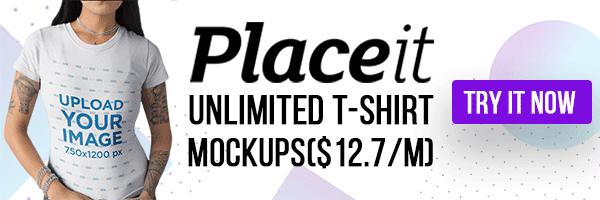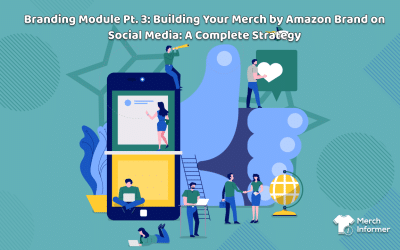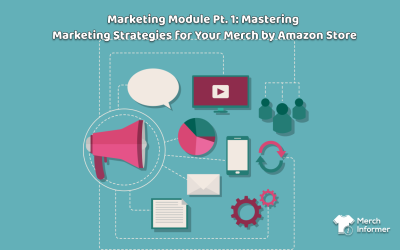Branding Module Pt. 1: Leveraging Your Merch by Amazon Products for Effective Branding
In the sprawling marketplace of Merch by Amazon (MBA), your brand needs to shout louder than a New Yorker hailing a cab in rush hour. So, buckle up! We’re about to take a deep dive into the art of using your own MBA product to brand itself, from strategic logo placement to creating a style so distinct, it’s recognizable from a mile away.
We’re not just slapping designs on products; we’re building a brand empire.
STRATEGIC LOGO/BRAND PLACEMENT ON MBA PRODUCTS
The apparel and fashion worlds are full of examples where the designer’s name or the company’s brand are incorporated into the product’s design. Since the days of Calvin Klein jeans, designers no longer hide behind their work, but feature themselves in it. The logo itself becomes a status symbol.
Now, you may not be a Louis Vuitton, but there’s no reason you can’t act like one.
- Logo Integration Challenges and Solutions: Using your logo as a small element within your design differentiates your work immediately – doing it tastefully and sensibly, however, will be your challenge.
One approach is to look at licensed goods. More often than not, studios will insist that the logo of the movie/show/game appear on the main design. Trust me, that can be a real pain – over the years, those of us in the business trained ourselves to either design around the logo, subtly integrate it as a background element, or even put it front and center with some stylization.
- Make The Logo The Star: The old way of establishing a logo as a brand was the aforementioned Calvin Klein route: create great designs and then gradually increase the amount of visual real estate the logo takes up. At first, it was a simple tag on the back pocket of the jeans. Now, a simple white tee with the Calvin Klein logo is considered an upscale item unto itself.
Look at brands like Supreme, which initially started with the familiar italicized white on red logo, then moved on to different colors and treatments of the logo, to the latest collections where the word “Supreme” is rendered in classic styles – abandoning the logo altogether.
- Here’s A Free Idea: Since I’m getting too old and busy to do this myself, I happily gift this concept to you: take famous logos from other brands and mock them up with the word(s) from your brand.
It’s a trick that’s done for parody apparel all the time. It will appeal to the fans of the IP you’re mimicking, even if they have no idea what your brand is. You’re welcome.
PRODUCT VARIETY AS BRANDING STRATEGY
MBA is not just about t-shirts. Though still limited, Amazon is expanding their base products, and my advice is to put your designs on as many products as possible. Even if t-shirts are the vast majority of your line, having a recognizable inventory of your products come up in searches or recommended items tells the customer that you are more than “just another t-shirt guy”.
Each product is an opportunity – a new canvas for your brand story. Just be smart about how to apply the designs to other products – an approach that works for a sweatshirt may not befit a tote bag. Adapt and conquer.
BRANDING THROUGH CONSISTENT DESIGN
Consistency in design is what makes a brand memorable and recognizable when your logo can’t speak for you.
Case in point: my close friend Ben owns “Fright Rags”, a company that specializes in licensed horror movie apparel and other products. Like many, he started with screen-printed t-shirts, front side only. A graduate of the famous Bauhaus University in Germany, Ben grew his brand by focusing on bold, exquisitely rendered illustrations by up-and-coming artists. Over time, Fright Rags’ painterly approach to famous horror movies became so popular that the shirts became sought-after collectibles unto themselves.
As with any successful enterprise, Fright Rags also spawned a host of imitators. So, Ben expanded his offerings beyond t-shirts to a wide range of apparel. As these too became bestsellers, the imitators followed, Ben expanded to a wider range of products, from action figures to lunchboxes. No matter how diverse the offerings, the style and quality Ben established remains consistent and recognizable.
If you’re looking for a blueprint for consistent design, you can’t do better than Ben’s example (just don’t try imitating him. I’ll come find you).
Here are a few tips on how to apply design consistency as a branding element:
- Crafting a Recognizable Design Language: Your designs should speak your brand’s language. Whether it’s through a recurring color scheme, a specific font style, or a unique design motif, make sure your products scream ‘you’.
- Finding Your Niche: What’s your brand’s superpower? Identify it and let it shine across your MBA portfolio. Whether it’s quirky humor, elegant minimalism, or vibrant patterns, own it.
- Contextual Recognizability: Your designs should be like an old friend in a crowd – instantly recognizable, even when they’re out of their usual context.
BEST PRACTICES
Your success in this area will vary, depending on whether your core approach toward the product line is business-forward or creative-forward, or both.
If you’re business-forward and creative elements are simply tools and assets that you require to advance your business, your view of what works here must be empirical. This is more difficult for non-creatives of course, but anyone can recognize some of the simple aspects below such as consistency.
If you’re creative-forward, visually identifying the elements below is much easier and gives you an advantage over non-creatives in recognizing what works. The challenge for creatives lies in the emotional foundation of any artist: knowing what to keep and what to let go of. Once you’ve recognized which designs fit the below criteria, you need to be at peace with the fact that some of your litter just ain’t gonna thrive.
- Effective Branding Do’s and Don’ts:
- Do ensure consistency across your product range.
- Don’t let your designs become monotonous or predictable.
- Do keep an eye on trends, but stay true to your brand essence.
- Avoiding Common Pitfalls: Beware of overcomplicating your designs or straying too far from your brand’s core message. Always keep the customer’s perspective in mind.
And there you have it – your blueprint for turning those Merch by Amazon products into powerhouses of your brand’s narrative. In the world of MBA, your products are more than just commodities; they are the storytellers of your brand, the messengers of your creative vision.
What’s worked for you? Any branding blunders you’ve learned from? Share your journey, your queries, or your “Eureka!” moments.







